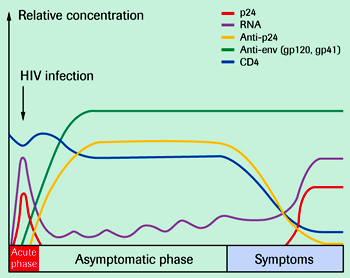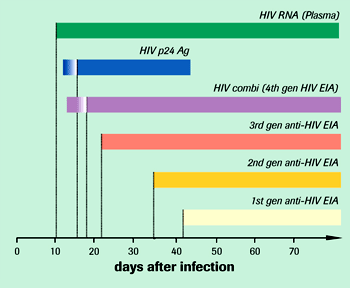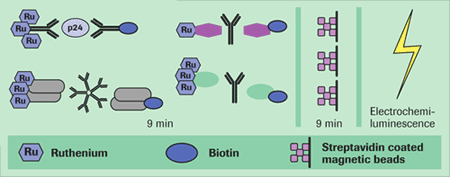|
First-line diagnosis
|
|
The major challenges in first-line HIV diagnosis are the early detection of infection and the reliable recognition of all HIV variants. Addressing these two issues contributes to:
- An earlier diagnosis to prevent the further spread of HIV infection
- Improvements in the safety of blood and its products
- A reduced response time for individual HIV testing after exposure e.g. needlestick injury
- A reliable diagnosis even when new variants are emerging in the virus population
How is first-line diagnosis of HIV infection done?
The cornerstone for first-line diagnosis of HIV infection is an immunoassay which recognizes antibodies to HIV. HIV specific antibodies are produced within a few weeks after infection depending on the phenotype of the infecting virus, the infectious dose, the transmission mode and the sensitivity of the assay used.
In the acute phase of HIV infection, HIV RNA, HIV antigen (p24) and early antibody response can be detected in serum or plasma samples. In the asymptomatic phase, RNA titers may vary, and antibodies against capsid and envelope proteins can be detected. In contrast, the HIV antigen is usually not detectable anymore in the blood. When AIDS symptoms appear in the late stage of infection, HIV antigen antigen and RNA rise again. Antibodies against p24 decline in the late stage, but antibodies against envelope proteins remain usually stable throughout HIV infection.

Time course of an HIV infection
|
What are 4th generation HIV immunoassays?
The HIV immunoassay may also contain a component which detects HIV antigen (p24) in addition to HIV antibodies (so-called HIV Ag/Ab combined assays or 4th generation HIV assay). The addition of p24 antigen detection into the immunoassay leads to an improved sensitivity in the early phase of infection. These 4rth generation HIV immunoassays have the advantage to detect HIV infection approximately 1 week earlier than conventional 3rd generation EIAs. The development of immunoassays to detect HIV infection has improved over time, e.g. by introducing components for the detection of divergent HIV variants like HIV- 1 group 0 into the test.

Early detection of HIV infection
What is Elecsys® HIV combi?
Elecsys HIV combi is an immunoassay for the qualitative detection of HIV antigen and antibodies in human serum and plasma.
The assay is used for the identification of HIV infections in HIV-infected individuals and in blood and blood products containing HIV.
Due to the 4th generation test format, Elecsys HIV combi detects HIV infection earlier than traditional HIV antibody assays. The assay is based on electroluminescence technology and uses tailor-made recombinant antigens derived from the polymerase and envelope proteins of HIV. This leads to an early detection of HIV infection and a broad recognition of all HIV variants.

Test principle of Elecsys HIV combi
For further information, please refer to the following:
Elecsys HIV Brochure (PDF)
HIV Booklet PDF (PDF)
http://www.roche.com/home/products/prod_diag/prod_diag_lab.htm
Elecsys is a trademark of Roche
|







